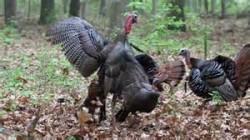
Most birds at the Thanksgiving table will come courtesy of Butterball, but fall turkey season runs through January 1, so theoretically some folks might have killed, cleaned and stuffed their own bird this year.
And old-timers might remember that the gobblers haven’t always been around in this neck of the woods.
According to Montana Fish, Wildlife and Parks: “Montana falls outside the wild turkey’s ancestral range and it is not native to Montana. When the Montana Department of Fish and Game decided to introduce turkeys into Montana, it selected the Merriam’s as the best choice to achieve success. In 1954, department biologists introduced 13 Colorado birds into the Judith Mountains of central Montana. A second release was made in 1955 when 18 turkeys from Wyoming were released into the Long Pines area of southeastern Montana. Wyoming stock was also used in the Ashland area of southeastern Montana in 1956 and 1957 when 26 birds were released. This marked the last time stock from outside Montana was transplanted. Subsequent trapping and relocating distributed turkeys through numerous sites in Montana.”
Hunters can chase toms in a special spring season and either sex in the fall. A special turkey license is required and hunters can only take one bird per season.
Though the birds can be found, it can be tough finding them and even tougher stalking them. The birds are very wary and have a keen sense of sight. FWP recommends scouting for sign before a hunt.
The following advice is also given via FWP:
“Once you spot a tom, mark his location and arrive there early the next morning before he leaves the roost tree. Some hunters use an owl hooter during the early morning to get roosted birds to call back. Hooters are commercial mouth-blown devices that imitate a large owl’s hoot. Once a gobbler is located, the hunter can move in quietly, then hide and use his turkey call.
If you don’t hear a bird gobble of its own volition, move through the woods and make several hen yelps every 300 to 400 yards. Such calling should be done only from a location where you can hide quickly and also have a good view of the surroundings.
- Be in the woods by the crack of dawn because this is when the breeding-age toms begin sounding off with lusty gobbles audible half a mile away on a still morning. Breeding-age toms do most of their gobbling during the first two hours of daylight, but during the height of the mating season, an occasional gobble may be heard at any time of the day.
- If you hear more than one tom gobbling, move in on the closest tom as fast as possible. Stalking a more distant tom may result in a busted stalk.
- When calling to a tom on the roost early in the morning, a couple of soft, sleepy clucks works better than the hen yelp. A tom is reluctant to respond to a love yelp so early in the morning.
- Whether you wear camouflage or not, your clothing should blend with the foliage around you. Although some hunters swear by facial camouflage and clothing, other good hunters are inclined to believe one’s movements spook turkeys.
- Where should you take a stand? After a gobbler sounds, try to move within 200 yards of his position and then choose a stand in a fairly open area. As a general rule, turkeys avoid thickets that could conceal an enemy. A turkey likes a certain amount of ground cover within the timber to make it feel secure. However, the ground cover must be open enough to instantly afford the turkey good vision, allow it to walk without touching or coming into bodily contact with thick ground growth and assure it quick wing action and passage if need be. Turkeys are like any other animals-their behavior is mostly directed toward survival. Once you are on a stand, sit still and be patient. Smoking, coughing and other unnecessary movements simply do not fit into the strategic plan for hunting turkeys.
- Try to get uphill and on the same ridge as a gobbler. It’s the easiest place to call from. Turkeys are a lot easier to call uphill than downhill.
- When selecting a calling site, look for a tree with a good thick base. Sit in front of it, and use it as a backrest.
- Weather conditions play a big part in the success of the spring gobbler hunt. A day that starts with a clear, cool morning and no wind is a good choice for hunting turkeys. Eastern Montana unfortunately has its share of inclement weather during the spring turkey season. Cold weather-especially when coupled with a foot of snow-usually dampens the amorous attitudes of gobblers, making calling almost useless. If such weather conditions occur, stay home, practice your calls, read up on the life history of the wild turkey and hope for a better day.
- Rifles are not a legal weapon for the spring season, most turkey hunters prefer using a 12-gauge shotgun with a full choke and using 0.2 or No. 4 shot. Turkeys are big, tough birds, and their vital organs are tucked away beneath heavy, metallic-colored feathers. Breeding-age toms also have what is called a breast sponge, which acts like a flak jacket. It’s a large mass of fatty tissue that helps them remain in prime physical condition during the breeding season. Wild turkeys also have blinding speed afoot, and even a broken wing seldom results in a turkey in the oven. Because a turkey’s body is nothing less than a miniature armored-tank, preferred areas to shoot at are head and neck.”